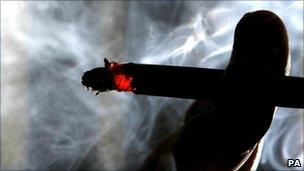Analysis: Why smoking is in the firing line
- Published

Smoking rates are hovering just above 20%
The sale and promotion of tobacco products are to be more heavily-regulated. It is just the latest in a long line of laws to reduce smoking rates. But will it work and why are law-makers so keen on targeting smokers?
Bans have been imposed on tobacco advertising and smoking in public places in recent years. The age at which people can buy cigarettes has been increased from 16 to 18.
Later this year, tobacco products will be taken out of vending machines - and now ministers are seeking to ban displays in shops and, perhaps, force manufacturers to use plain packaging.
Smoking, it is fair to say, is probably the most regulated mass habit around.
But a quick look at smoking rates explains why the government is taking an increasingly tough stance.
In the 1950s, when the link between smoking and lung cancer was established beyond doubt, eight in 10 men smoked.
By 1974, 45% of adults were smokers and this continued to fall until it dipped under a quarter in 2001.
But since then the numbers have started levelling off. Some 21% of adults still smoke, with manual groups twice as likely to do so as professional groups.
Children
What is more, the number of child smokers remains worryingly high. One in seven 15-year-olds say they are regular smokers.
Health Secretary Andrew Lansley wants this to change - and believes the steps set out in his tobacco control strategy will help.
He has set "national ambitions" to reduce smoking in adults from 21.2% to 18.5% by 2015. There are specific goals for teenagers and pregnant women too.
It promises to be a challenging target. Many experts have argued that there is now a hardcore group of smokers that will continue regardless of the health warnings and government action.
But Professor Anne McNeill, an expert in health policy and promotion at Nottingham University, disagrees.
She cites the experience of California in the US which has got smoking rates under the magical 20% figure. She said the targeting of health messages at certain groups as well as steps, such as the display ban, to denormalise the habit were key.
But only time will tell whether banning shop displays and - if it happens - enforcing plain packaging will actually work in England.
In terms of the display ban, there is evidence already out there about the effect it could have. A host of countries, including Canada, Ireland, Finland, and Iceland, have already forced shops to keep tobacco products under-the-counter.
Students Daniella Boyd-Waters and Ali Hares say tobacco display ban will 'make no difference.'
And where this has happened, there are signs smoking rates have fallen. In Saskatchewan, the first Canadian province to remove displays, youth smoking fell by a quarter in five years. Iceland also saw a fall of over 10% after its ban came into place in 2001. Other countries have reported similar patterns.
A study of 25,000 young people in New Zealand found 15-year-olds exposed to shop displays were three times more likely to try smoking. In fact, researchers found shop displays were an even greater risk factor than parental smoking.
But introducing legislation does cost industry. A review of the Irish ban by the UK Association of Convenience Stores found the average cost of compliance was 拢300 per store. In Canada, it was even more. Although manufacturers helped many stores pay for the changes.
Industry has also been adamant that banning displays and plain packaging will boost the black market in illicit cigarettes. The evidence on this is inconclusive, although there are suggestions that a display ban makes it harder for enforcement agencies to identify counterfeit products.
- Published9 March 2011
- Published7 March 2011
- Published21 November 2010
- Published24 November 2011